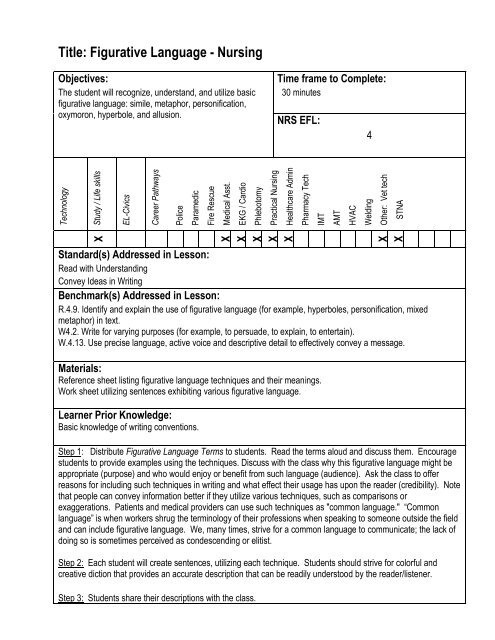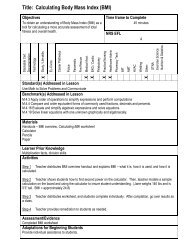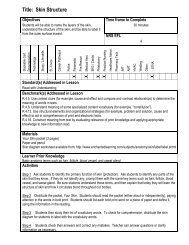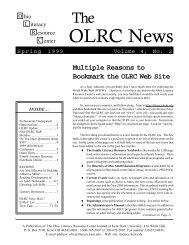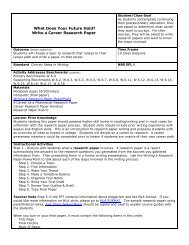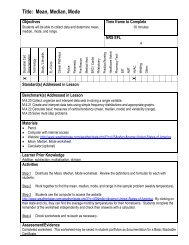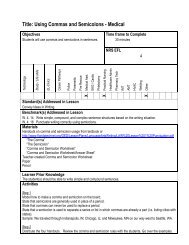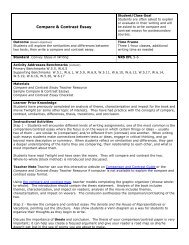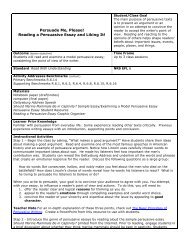Figurative Language (nursing)
Figurative Language (nursing)
Figurative Language (nursing)
You also want an ePaper? Increase the reach of your titles
YUMPU automatically turns print PDFs into web optimized ePapers that Google loves.
XXXXXXXXTechnologyStudy / Life skillsEL-CivicsCareer PathwaysPoliceParamedicFire RescueMedical Asst.EKG / CardioPhlebotomyPractical NursingHealthcare AdminPharmacy TechIMTAMTHVACWeldingOther: Vet techSTNATitle: <strong>Figurative</strong> <strong>Language</strong> - NursingObjectives:The student will recognize, understand, and utilize basicfigurative language: simile, metaphor, personification,oxymoron, hyperbole, and allusion.Time frame to Complete:30 minutesNRS EFL:4Standard(s) Addressed in Lesson:Read with UnderstandingConvey Ideas in WritingBenchmark(s) Addressed in Lesson:R.4.9. Identify and explain the use of figurative language (for example, hyperboles, personification, mixedmetaphor) in text.W4.2. Write for varying purposes (for example, to persuade, to explain, to entertain).W.4.13. Use precise language, active voice and descriptive detail to effectively convey a message.Materials:Reference sheet listing figurative language techniques and their meanings.Work sheet utilizing sentences exhibiting various figurative language.Learner Prior Knowledge:Basic knowledge of writing conventions.Step 1: Distribute <strong>Figurative</strong> <strong>Language</strong> Terms to students. Read the terms aloud and discuss them. Encouragestudents to provide examples using the techniques. Discuss with the class why this figurative language might beappropriate (purpose) and who would enjoy or benefit from such language (audience). Ask the class to offerreasons for including such techniques in writing and what effect their usage has upon the reader (credibility). Notethat people can convey information better if they utilize various techniques, such as comparisons orexaggerations. Patients and medical providers can use such techniques as "common language." “Commonlanguage” is when workers shrug the terminology of their professions when speaking to someone outside the fieldand can include figurative language. We, many times, strive for a common language to communicate; the lack ofdoing so is sometimes perceived as condescending or elitist.Step 2: Each student will create sentences, utilizing each technique. Students should strive for colorful andcreative diction that provides an accurate description that can be readily understood by the reader/listener.Step 3: Students share their descriptions with the class.
Assessment/Evidence:Students will share their sentences with classmates and discuss which are more effective and strive to determinewhy some are more effective than others.Adaptations for Beginning Students:Beginning students may be prompted with ideas offered by peers or the instructor. Such students may also begiven extended time.Adaptations for Advanced Students:Advanced students may be asked to write more than the exercise requires. They may also be challenged to writea poem instead of prose. In addition, they may be given a challenging time limit for completing the assignment.Teacher Reflection/Lesson Evaluation:Students should easily perceive the importance of figurative language for creating vivid and accuratecommunication.This lesson was created by Middletown ABLE.
Literary Terms<strong>Figurative</strong> <strong>Language</strong>Definitions and Examplessimile - comparison using like or asHis voice sounded like a machine in need of oil.metaphor - comparison without using like or asThe hallways were tunnels of silence.personification - giving human characteristics to the non-livingThe curtains drowsily hugged the window.oxymoron - two words which contradict one anotherThe jumbo shrimp were featured on the menu.allusion - a reference to a person, place, or event of which most people are awareThe tall, lanky youth thought himself a Romeo.hyperbole - an exaggeration or overstatementI have a thousand patients to see this evening.
Literary Terms<strong>Figurative</strong> <strong>Language</strong>ExercisesUse a simile to finish these statements1. The patient was as nervous as_____________________________________________________________________________________2. The 911 caller was as upset as_____________________________________________________________________________________3. The nurses chattered like_____________________________________________________________________________________4. The medication smelled like_____________________________________________________________________________________5. The doctor was as_______________________________ as __________________________________6. The emergency room was as ___________________________ as ___________________________7. The wound was as ______________________as __________________________________


